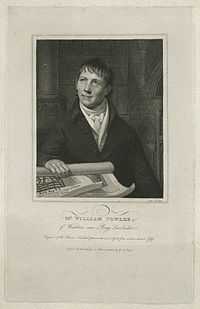William Fowler (artist)

William Fowler (1761–1832), was an English artist.
Fowler was born at Winterton, Lincolnshire, 12 March 1761. His father was Joseph Fowler, a builder at "The Chains" in West Street.
Fowler became an architect and builder at Winterton, and about 1796 made drawings of Roman pavements discovered there. He took them to London to be engraved by his brother-in-law, Mr Hill. There he studied the process of copper-plate engraving, and in April 1799 brought out his own coloured engraving of a Roman pavement at Roxby. Between 1799 and 1829 he published three volumes of coloured engravings of twenty-five pavements, thirty-nine subjects from painted glass, five brasses and incised slabs, four fonts and eight miscellaneous subjects. He also created at least twenty-nine unpublished engravings, mostly of objects of antiquity. Many of the published plates were accompanied by printed broadsides.
He became acquainted with Sir Walter Scott and other celebrities, and was presented on at least one occasion to the royal family at Windsor. Some of his work can be seen in North Lincolnshire Museum in Scunthorpe and Baysgarth House Museum in Barton-on-Humber.
Sir Joseph Banks said of him: "Others have shown us what they thought these remains ought to have been, but Fowler has shown us what they are, and that is what we want."[1] According to the Dictionary of National Biography his works are distinguished by a strict fidelity especially remarkable at the time. Whenever it was possible he worked from tracings, rubbings, etc. It is claimed that he was the first to introduce the lead-lines in representations of painted glass.[1] There is a characteristic portrait of him by W. Bond, from a painting by George Francis Joseph, A.R.A., dated 4 June 1810.
Fowler, though a member of the Church of England, was also a ‘class-leader’ among the Methodists.
He died 22 September 1832, and was buried at Winterton under a cruciform slab.
References
![]() This article incorporates text from a publication now in the public domain: "Fowler, William (1761-1832)". Dictionary of National Biography. London: Smith, Elder & Co. 1885–1900.
This article incorporates text from a publication now in the public domain: "Fowler, William (1761-1832)". Dictionary of National Biography. London: Smith, Elder & Co. 1885–1900.